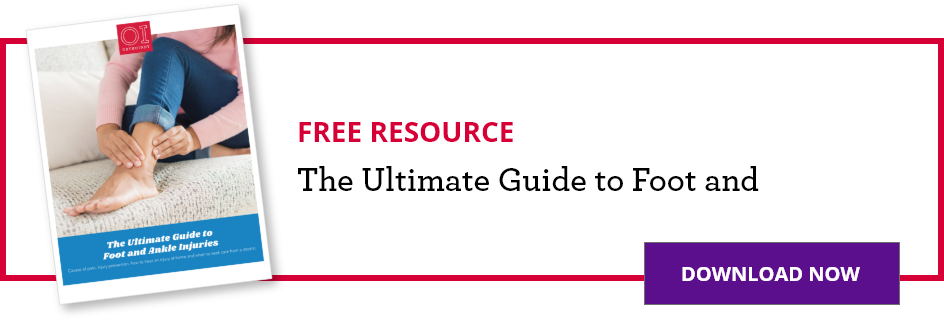THIS IS PART OF THE ULTIMATE GUIDE TO FOOT AND ANKLE INJURIES
Plantar fasciitis occurs when the strong band of tissue that supports the arch of the foot becomes irritated and inflamed. This condition is usually the most common cause of pain on the bottom of your foot.
OrthoIndy foot and ankle doctor, Dr. Daniel Lehman discusses the most common causes, symptoms and treatment options for plantar fasciitis.
Anatomy
The plantar fascia is the long, thin ligament that supports the arch of the foot and lies directly beneath the skin on the bottom of the foot. Plantar fascia absorbs the high stresses and strains we place on our feet.
Inflammation of the plantar fascia ligament will irritate the bottom of your foot, causing pain.
What is the main cause of plantar fasciitis?
“There’s not a generally agreed upon cause for plantar fasciitis,” Dr. Lehman said. “Most likely it is due to some combination of overuse in patients who are predisposed to irritation of their plantar fascia due to a tight Achilles tendon.”
Pain usually develops when too much pressure on the bottom of the feet damages or tears the plantar fascia tissues. Plantar fasciitis causes inflammation, heel pain and stiffness.
Most commonly it develops without a specific reason and only on one side of the body. However, obesity, tighter calf muscles, a high foot arch, repetitive impact activities such as running, or a new activity may play a role in the likelihood of it developing.

Plantar Fasciitis Symptoms
Plantar fasciitis pain doesn’t usually radiate, it stays local to the bottom of the heel. Your pain may increase when weight is placed on the heel so staying off your feet may alleviate your symptoms.
“Pain is typically worse when standing up first thing in the morning as well as after sitting for a prolonged period of time,” Dr. Lehman said.
Some other common plantar fasciitis symptoms include:
- Pain on the bottom of the foot near the heel
- Greater pain after exercise or activity
Physician Examination
Your foot and ankle doctor will ask you for a complete medical history, ask you to describe your symptoms and conduct a physical examination. An X-ray or MRI may be necessary to rule out other problems.
MAKE AN APPOINTMENT WITH AN FOOT AND ANKLE SPECIALIST AT ORTHOINDY
What is the best treatment for plantar fasciitis?
Your orthopedic doctor will start with non-surgical treatment options such as basic exercises and stretches to increase your movement and decrease pain without surgery.
Dr. Lehman suggests wearing supportive shoes when you’re walking and do some Achilles tendon stretches to improve your pain.
How to treat plantar fasciitis with nonsurgical treatments:
- Ice
- Rest
- Anti-inflammatory medication such as ibuprofen
- Plantar fasciitis exercises and stretches
- Taping the foot
- Cortisone injections
- Orthotics and shoe inserts
- Night splints
- Physical therapy
In extreme cases, when plantar fasciitis symptoms persist after 12 months of nonsurgical treatment, your foot and ankle doctor may consider surgical treatment. Surgery generally consists of a release of a portion of the plantar fascia to decrease the pull on the plantar fascia.
“There is no one treatment that works for every patient so treatment may evolve to different modalities depending on the patient’s response,” Dr. Lehman said.
The majority of cases can be treated without surgery and symptoms will go away within 12 months. If plantar fasciitis surgery is necessary, it takes several months for pain to completely resolve afterwards. Treatment takes time and there isn’t a way to heal plantar fasciitis quickly. Dr. Lehman usually sees significant improvement within a few months of treatment.
Plantar Fasciitis Physical Therapy
If you’re new to physical therapy stretches or you desire a little more help, your foot and ankle doctor may suggest going through your therapy exercises with a physical therapist.
Your physical therapist will focus on stretching out your plantar fascia by showing you a series of exercises. They may also show you how to apply athletic tape to support the bottom of your foot. This will make your heel and ankle more stable.
Plantar fasciitis treatment with your physical therapist may also include:
- Ice treatments
- Massage
- Medication to decrease inflammation
Plantar Fasciitis Risks and Prevention
Plantar fasciitis doesn’t always have an obvious cause. However, there are several risk factors which make individuals more susceptible to the condition.
Some of these risk factors include:
- Being between the ages of 40 and 60
- Certain activities like distance running, ballet and any sort of dance – any exercise putting high amounts of stress on your heel
- Having flat feet or a high arch
- Standing occupations such as a teacher or construction worker
- Obesity
Making frequent changes to your footwear and activities will help provide some plantar fasciitis relief.
Some helpful tips for prevention include:
- Mixing up your exercise routine. Instead of running every day, incorporate some low impact aerobic exercises like swimming or cycling.
- Stretching before you exercise. Whether you’re going on a long run or a bike ride around the block, make sure your calves, plantar fascia and Achilles tendon are stretched properly
- Staying at a healthy weight. Maintaining a healthy body weight will decrease your chance of plantar fasciitis, with less pressure on the heel.
- Wearing supportive shoes. Good arch support and sturdy shoes will help keep your plantar fascia healthy.
- Keeping your activities gradual. A new or sudden increase in activity can potentially damage or irritate your plantar fascia.
To schedule an appointment with Dr. Lehman, please call 317.802.2818 or learn more about OrthoIndy Foot and Ankle and Dr. Lehman.
Schedule an appointment
Your well-being is important to us. Click the button below or call us to schedule an appointment with one of our orthopedic specialists. If your injury or condition is recent, you can walk right into one of our OrthoIndy Urgent Care locations for immediate care. For rehabilitation and physical therapy, no appointment is needed to see one of our physical therapists.





